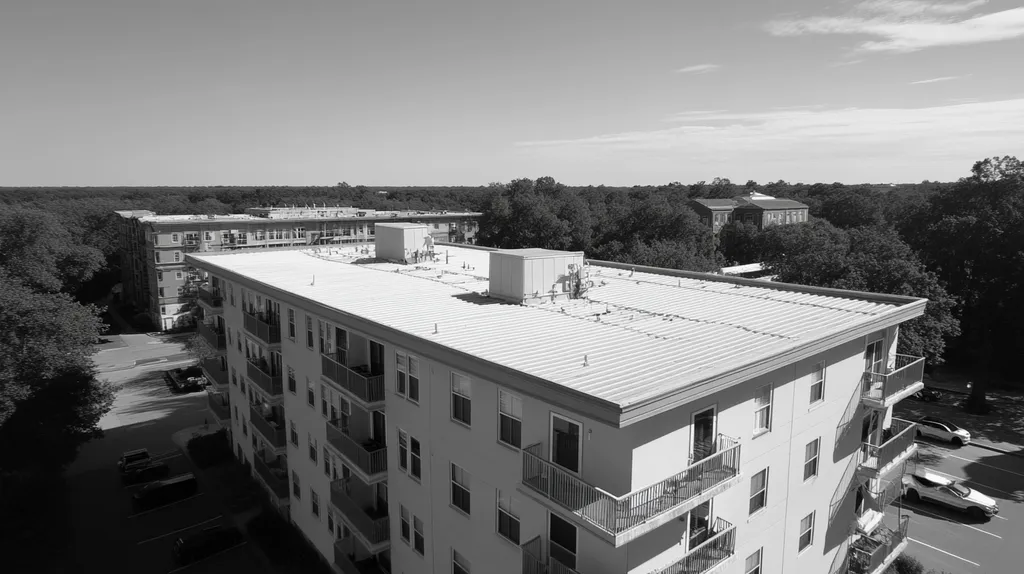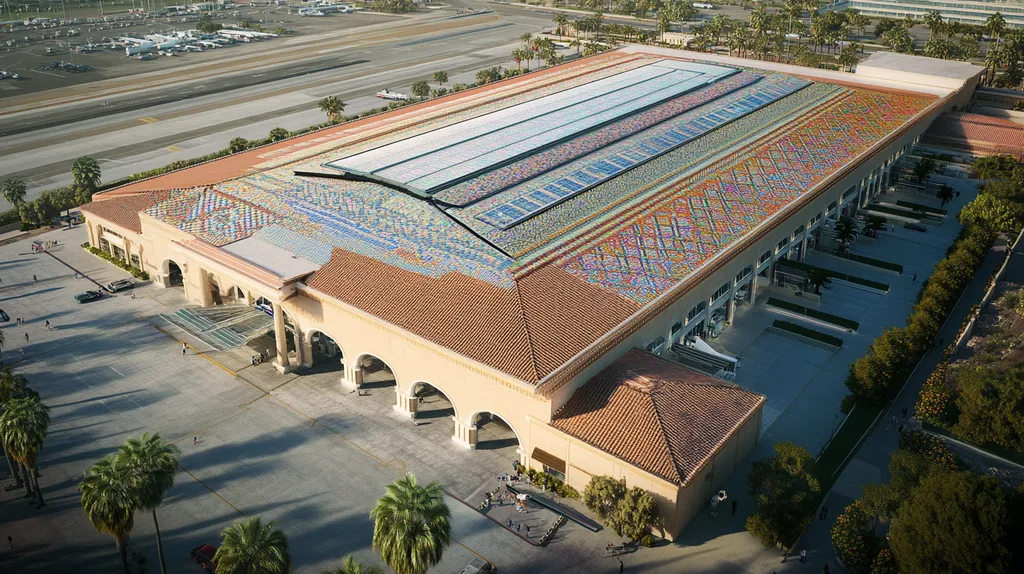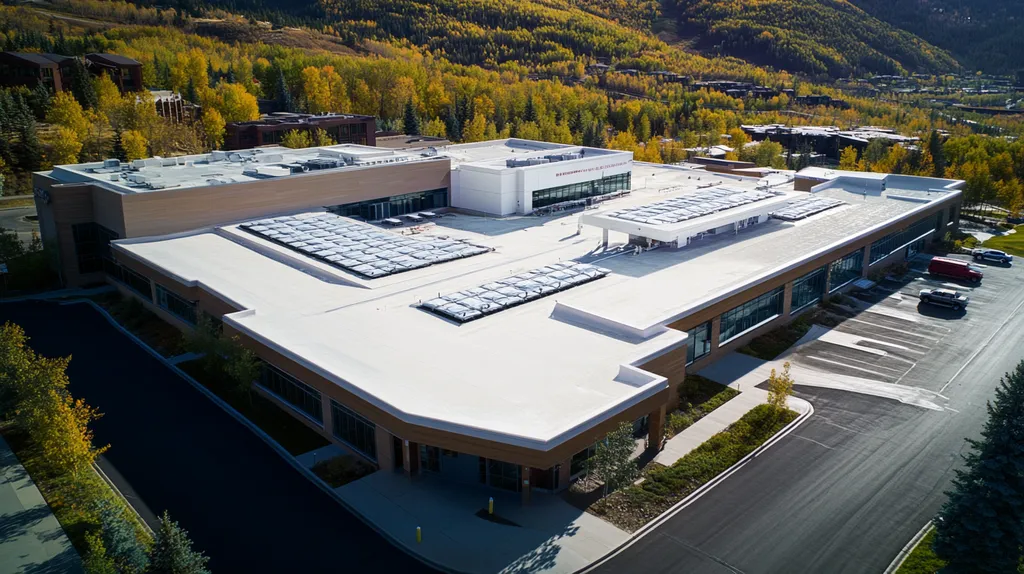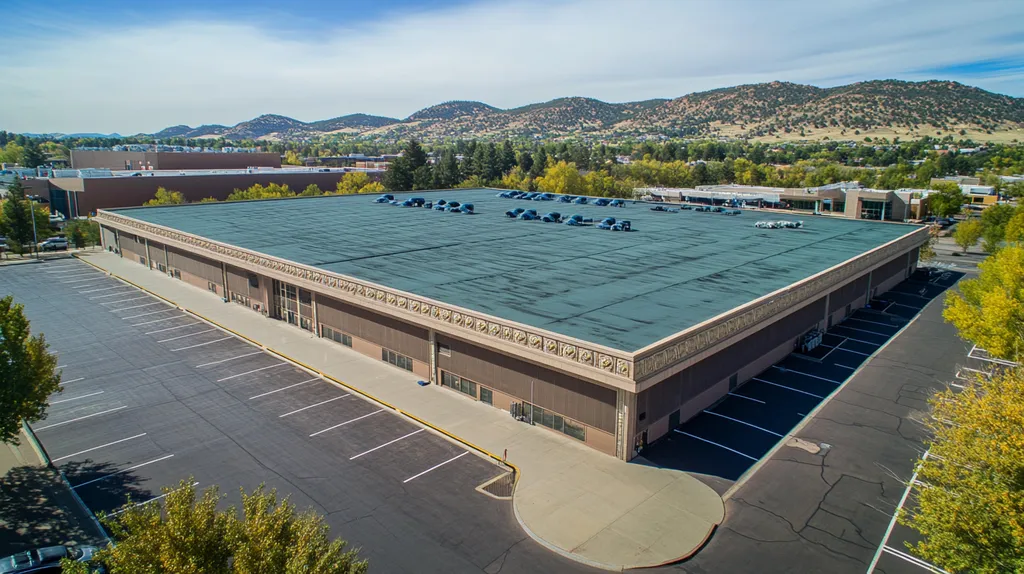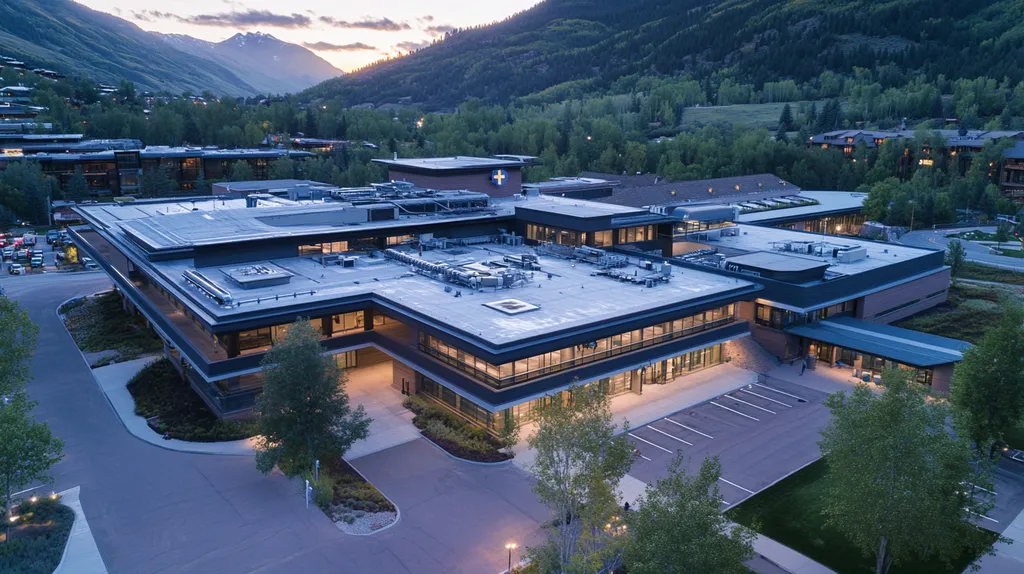Every year, industrial facility owners lose millions due to premature roof failures and emergency repairs that could have been prevented through proper assessment. Studies show that up to 40% of all industrial roofs fail before reaching even half their expected lifespan.
Understanding your roof’s long-term value isn’t just about preventing leaks—it’s about protecting your entire facility investment and avoiding costly operational disruptions.
This comprehensive guide breaks down the essential components of industrial roof assessment, from basic terminology to practical decision-making factors, empowering facility owners to make informed choices that maximize their roofing investment for years to come.
SECTION 1: THE BASICS EXPLAINED
When it comes to industrial roofing, understanding its long-term value isn’t just important—it’s essential for facility owners. Ignoring your roof could result in hefty financial setbacks, with the potential for repairs and replacements racking up thousands of dollars in costs. Did you know that companies can spend as much as 50% of their operational expenses on fixing problems as they arise? That’s why it’s critical to prioritize proactive assessments. This section will clarify what an industrial roof assessment is, why it matters for your building, and how the whole process unfolds.
What It Is (In Plain Language)
An industrial roof assessment is like a health check-up for your building’s roofing system. This thorough inspection dives into every detail, searching for signs of wear, damage, or anything that could lead to future problems. Experienced roofing professionals scrutinize components such as the membrane, seams, and drainage systems, discovering issues that may be hiding out of sight.
The assessment also evaluates the roof’s lifespan and the integrity of its materials. By getting a clear picture of the roof’s current condition, property owners receive crucial data that informs decisions regarding maintenance or replacement.
This forward-thinking approach helps catch small issues before they balloon into major, costly repairs. It gives facility owners and managers the insights they need to maximize their roofing investments over time.
In essence, an industrial roof assessment acts as a key resource, guiding stakeholders in understanding how much life is left in the roof and when it’s time to take action.
Why It Matters (To Your Building)
The performance and longevity of an industrial roof have a direct impact on the overall well-being of a facility. A well-maintained roof serves as a shield, protecting the interior from water leaks, mold, and even structural damage. Preventing these problems can save property owners substantial amounts in repairs and insurance costs.
Additionally, a roof in tip-top shape enhances energy efficiency, leading to lower utility bills. Facilities boasting efficient roofing systems experience reductions in operational costs, which can substantially bolster the bottom line over time.
Understanding the significance of regular roof assessments fosters a culture of proactive upkeep. Facility managers who prioritize these evaluations can mitigate risks and significantly extend the lifespan of their roofs.
Simply put, investing in routine roof assessments is a savvy move that not only protects the building but also boosts its value.
How It Works
The journey of assessing an industrial roof begins with a thorough visual inspection. Skilled professionals will venture onto the roof, looking for visible damage like blisters, cracks, or leaks, while also checking for pooling water that might signal drainage issues.
But visual inspections are just the start! Some assessments leverage advanced technologies such as infrared scanning or moisture mapping to uncover hidden moisture that could jeopardize the roofing system’s durability.
Once the inspection wraps up, a detailed report surfaces, outlining potential concerns and suggested actions. This document serves as a strategic roadmap for future maintenance, complete with timelines and cost estimates for necessary repairs or replacements.
In conclusion, an effective roof assessment combines traditional inspection methods with innovative technologies, empowering property owners to make informed choices that safeguard their investments while extending the lifespan of their roofs.
SECTION 2: PRACTICAL APPLICATIONS
Understanding the practical applications of an industrial roof is critical for facility owners. Making informed choices about roofing can significantly influence the long-term value of a property. A neglected roof can spark issues like water damage, safety risks, and expensive repairs. Misjudging a roof’s lifespan might lead to unexpected financial burdens. This section explores common uses and examples of industrial roofs, when assessments are most essential, and their interactions with other building systems.
Common Uses & Examples
Industrial roofs serve multiple functions that go beyond simply shielding facilities from the weather. Many buildings, such as warehouses and manufacturing plants, utilize flat or low-slope roofing systems to maximize usable space. For example, a rooftop garden can provide additional insulation while promoting energy savings. On the flip side, selecting inappropriate roofing materials may lead to leaks and structural challenges down the line.
Another notable use involves solar panel installations. Businesses increasingly capitalize on their commercial roofs as platforms for solar energy systems, greatly slashing energy costs and advancing sustainability. However, it’s essential to ensure that the roofing material can support the weight of these panels without compromising structural integrity.
Industrial roofs can also be specially configured to accommodate exhaust systems or HVAC units. The design of the roofing system must consider these elements carefully. Proper installation and ongoing assessments are key to maintaining both functionality and efficiency.
In essence, recognizing these diverse applications helps tailor assessment protocols effectively. Ignoring these factors can lead to wasted resources and a decline in property value.
When You Need It Most
Timely roof assessments are crucial after significant events, especially severe weather. High winds, heavy snow, or hail can wreak havoc on roofing materials, leading to leaks or system failures. Property owners should conduct thorough inspections right after such occurrences to catch potential problems before they escalate.
Another critical moment for assessments occurs during routine maintenance schedules. Establishing a regular roof inspection routine helps identify minor issues early on. For instance, fixing a small crack in the membrane can prevent major water infiltration that results in costly repairs.
Assessments also become particularly urgent during major changes to the facility, such as renovations. Alterations to skylights or HVAC systems need to take the roof’s structural integrity into account. This not only ensures safety but also reassesses the roof’s long-term performance.
Neglecting these pivotal moments can lead to costly repercussions, including higher repair costs and lost productivity. Owners and managers must prioritize regular assessments to protect their investments.
Interactions With Other Systems
The industrial roof’s role is interconnected with various building systems. Effective drainage, for example, is critical for maintaining roof integrity. Clogged gutters or downspouts can lead to ponding water, which damages roofing materials and increases leak risks. Each component of the roof must work harmoniously with the building’s drainage system.
Additionally, insulation under the roofing material plays a vital role in energy efficiency. A compromised roof can jeopardize proper insulation, leading to inflated heating and cooling bills. Assessments should also evaluate insulation conditions to ensure optimal energy performance.
Mechanical systems, like HVAC and exhaust units, frequently interact with the roof as well. Regular assessments help ensure these systems don’t create unnecessary wear and tear on roofing materials. Proper implementation and maintenance of all systems will prevent complications that could undermine the roof’s performance.
In summary, understanding how roofs interact with other systems is essential for maximizing a building’s overall functionality and longevity. Comprehensive assessments shed light on these connections, facilitating smarter decision-making for property owners and managers.
SECTION 3: KEY TERMINOLOGY DECODED
Grasping roofing terminology is vital for facility owners and managers alike. Misunderstanding these terms can lead to costly missteps during assessments and decision-making. For instance, knowing the difference between “thermal resistance” and “insulation R-value” can vastly influence energy efficiency calculations, affecting budgets and comfort levels. This section will unravel essential roofing terms, translate the industry’s complicated jargon, and simplify measurement units to ensure everyone is on the same page.
Essential Terms Explained
First up is “thermal resistance,” often called R-value. This vital measurement reveals how well a material can resist heat flow. The higher the R-value, the better the insulation, which can significantly lower energy costs over time. Another essential term is “waterproofing,” which encompasses techniques that prevent water entry. Effective waterproofing is crucial to avoid leaks and structural damage, keeping facilities safe and sound.
“Membrane” is another key term in industrial roofing. Membranes act as protective barriers against water intrusion and can be made from various materials, such as TPO or EPDM. Understanding the different types of membranes and their expected longevity is crucial for evaluating the durability of the roof.
Lastly, “life cycle cost” (LCC) sums up the all-around expenses of owning a roof throughout its lifetime, including installation, maintenance, and replacement. Analyzing LCC equips facility managers with the knowledge to make financially sound roofing decisions.
Industry Jargon Translated
Navigating industry jargon can feel like deciphering a secret code. For instance, “slope” refers to the angle of the roof’s surface. Roofs fall into categories like flat, low-slope, or steep-slope, each affecting drainage and overall performance. Misunderstanding slope can lead to ineffective drainage solutions, setting the stage for leaks and water damage.
The term “drainage system” refers to the mechanisms that channel water off the roof. Effective drainage is crucial in preventing ponding, which can erode roofing materials. Failing to appreciate the importance of a well-designed drainage system may lead to expensive structural problems down the road.
Lastly, “retrofit” pops up when discussing roof upgrades. Instead of full replacement, a retrofit means adding new materials or systems to enhance performance. This approach can be more budget-friendly but requires a good understanding of existing conditions to ensure everything works well together.
Measurement & Units Simplified
Roofing measurements can often seem daunting. For instance, the term “square” is an industry staple, representing 100 square feet and serving as a standard unit for roofing materials. Knowing this makes it easier to estimate material needs, streamlining budgeting and planning.
Another important unit is the “mil,” which measures thickness and equals one-thousandth of an inch. This measurement is essential for assessing roof membrane thickness; generally, thicker membranes provide better durability and longer life spans, which can dramatically affect the cost-per-square-foot calculations.
Finally, “pounds per square foot” (PSF) gauges how much weight a roofing structure can support. Understanding PSF is vital in preventing overloading concerns, ensuring safety and sustainability. Accurate PSF calculations are indispensable during roof assessments and safety evaluations, safeguarding both the building and its occupants.
SECTION 4: DECISION FACTORS
When it comes to roofing, the stakes are high! Making the right choices can save property owners from unexpected expenses and disruptions down the line. A hasty decision could lead to repair costs soaring into the tens of thousands, especially if damage is allowed to escalate. It’s crucial for facility managers to navigate the intricate landscape of cost, performance, and durability. In this section, we’ll delve into cost considerations, performance trade-offs, and the factors that influence the lifespan and durability of industrial roofs.
Cost Considerations
Initial costs can be enticing, but digging deeper reveals that long-term financial implications are equally—if not more—critical. Industrial roofing systems come with a wide range of price tags that can dramatically influence budgeting strategies. For instance, investing in a premium thermoplastic polyolefin (TPO) roof might seem steep at first, but it offsets costs down the road through energy efficiency and reduced maintenance.
Then there are the hidden costs that creep up during a roof’s life cycle. Maintenance, repairs, and unexpected leaks can all strain budgets when not properly planned for. A roof built to last may reduce these ongoing expenses as it requires less frequent upkeep and fewer extensive repairs.
Warranties also play a vital role in cost evaluation. A solid warranty on a roofing system can save owners a bundle in repair costs over time, proving invaluable amid unforeseen issues. Grasping the balance between upfront costs and long-term value positions facility managers to make smart, sustainable roofing choices.
In short, effective cost analysis goes beyond just the initial investment—it’s about considering the entire financial picture, including future maintenance and warranty benefits.
Performance Trade-offs
Performance is a top priority when evaluating industrial roofs, and the right decision hinges on weighing performance characteristics against costs. While some roofing options may fit snugly within a limited budget, they might falter under extreme weather conditions, leading to premature failures.
Thermal performance is one of these key areas. A roof designed for superior insulation can lead to lower energy bills, making it a worthwhile investment despite higher initial costs. Energy-efficient roofing solutions, such as reflective membranes, can significantly reduce cooling expenses and enhance indoor comfort.
In addition, features like fire ratings and wind uplift resistance are crucial. Roofs designed with high wind resistance help minimize storm damage, saving significant amounts on repairs. Ensuring that performance trade-offs align with specific facility needs and local climate conditions is vital for informed decision-making.
Ultimately, balancing upfront costs and performance ensures that facility managers can obtain roofs that not only meet their immediate needs but also provide lasting benefits.
Lifespan & Durability Factors
The lifespan of an industrial roof directly impacts its long-term value. Different materials offer varying life expectancies; for instance, while asphalt shingles may grace a roof for 15–20 years, metal roofs can last over 50 years! Understanding these differences is crucial for sound financial planning.
Durability is another critical aspect—roofing materials need to stand up to local weather effects, from heavy snowfall to blazing sun. Facility managers in regions with harsh climate conditions should opt for materials celebrated for their resilience, as a well-built roof will not only withstand the elements but also necessitate fewer repairs down the line.
Moreover, ongoing maintenance can dramatically extend a roof’s life. Implementing regular inspections enables early detection of minor issues before they become major headaches. A diligently maintained roof can far exceed its expected lifespan, delivering exceptional value generation over time.
In conclusion, focusing on both lifespan and durability through thoughtful material selection and robust maintenance strategies can yield significant long-term benefits, protecting your investment for years to come.
SECTION 5: COMMON CHALLENGES
Confronting the long-term value of industrial roofs requires understanding the common challenges that facility owners encounter. A startling statistic reveals that nearly 30% of industrial roofs fail within their first 20 years, highlighting the critical need for ongoing maintenance and timely repairs. This section unpacks frequent issues, signs to be on the lookout for, and effective preventative strategies that can safeguard your investment.
Frequent Problems & Solutions
Industrial roofs frequently face issues like leaks, ponding water, and membrane damage. Leaks typically originate from wear and tear or broken seals, wreaking havoc on interiors and causing operational delays. Regular inspections are crucial for catching these issues early, allowing for specific repairs that can significantly extend the roof’s lifespan.
Ponding water is another prevalent issue that can place undue structural stress on the roof. To combat this, installing tapered insulation can help direct drainage while ensuring roof integrity remains intact. Additionally, proper drainage systems play a vital role in enhancing overall roof performance.
Membrane damage due to UV radiation or debris is common in industrial settings. Upgrading to more robust materials can help reduce these risks. Opting for reinforced membranes or adding protective coatings is essential for prolonging roof life and ensuring it withstands the elements.
Lastly, inadequate ventilation can create trapped moisture, fostering conditions ripe for mold and mildew growth. Integrating effective ventilation systems can minimize these risks and bolster the roof’s durability, ensuring it performs well over time.
Warning Signs To Watch For
Facility owners should be on the lookout for telltale warning signs that signal potential roof problems. Notable water stains on ceilings or walls are often the first indications of leaks or water infiltration. Ignoring these can lead to extensive internal damage and hefty repair costs.
A blistering or bubbling roof surface is another red flag. This condition usually points to trapped moisture within the roofing system, which threatens structural integrity. Swift action is necessary to address and repair blisters before they escalate into larger issues.
Cracks or tears in the roofing membrane are also significant warning signs of impending failure. These fissures facilitate further water penetration, which can lead to severe damage if left unchecked. Regularly inspecting the membrane is vital for catching these potential problems early.
Finally, evaluating roof drainage systems is critical. Clogged drains or visible debris can block water flow, leading to ponding. Routine maintenance and clean-outs are essential for preventing water-related problems and protecting the roofing system from further complications.
Preventative Approaches
Taking a proactive approach to roof maintenance can notably enhance long-term value. Regular professional inspections play a crucial role in spotting issues before they spiral out of control. Monthly checks can uncover subtle wear and potential problems, allowing for timely corrections.
Establishing a routine maintenance schedule can significantly reduce the risk of serious damage. This includes cleaning gutters, checking seams, and applying protective coatings as necessary. A well-maintained roof can exceed its expected lifespan and deliver substantial long-term savings.
Additionally, investing in high-quality roofing materials pays dividends in the long run. Selecting durable options designed to withstand specific environmental challenges helps mitigate future maintenance challenges.
Lastly, ongoing training for maintenance staff is vital. Educating team members about roof systems allows them to identify and address issues swiftly, preserving the lifespan of roofing assets over time.
SECTION 6: NEXT STEPS & RESOURCES
The journey of assessing the long-term value of an industrial roof is filled with high stakes. A roof that’s improperly installed can spiral into costly leaks, structural damage, and revenue losses due to unexpected downtime. To navigate this landscape successfully, property owners and facility managers must be proactive, gathering essential information and posing the right questions. This section guides you through crucial inquiries to make when dealing with providers, the importance of industry standards, and ways to deepen your roofing knowledge.
Questions To Ask Providers
When it comes to making informed roofing decisions, the right questions can pave the way. Start by asking about the materials and systems in use. For instance, how do various materials stack up in terms of energy efficiency and durability?
Next, dive into warranty terms and conditions. Knowing what is covered can safeguard your facility from unexpected future expenses.
Don’t hesitate to ask about the provider’s previous projects and client references. These insights can help you assess their reliability and the quality of their workmanship.
Finally, inquire about their maintenance programs. Regular upkeep is essential for maximizing the lifespan and performance of a roof, ensuring it stands strong well into the future.
Industry Standards & Guidelines
Being well-versed in industry standards is your best ally when evaluating roofing options. The American Society for Testing and Materials (ASTM) provides specifications aimed at enhancing material performance.
Also, look to the National Roofing Contractors Association (NRCA) for best practice guidelines on installation and maintenance procedures. These resources are invaluable in navigating your roofing journey.
Staying informed about local building codes is equally important. These regulations dictate everything from material choices to installation methods, ensuring safety and compliance throughout the project.
Consistently reviewing these standards puts you in a position to make informed decisions that align with the industry’s best practices.
Further Learning Simplified
Staying informed about roofing systems can empower property owners and facility managers. Online resources including webinars, courses, and industry publications are fantastic avenues for broadening your knowledge base.
Moreover, attending trade shows and industry conferences allows for valuable face-to-face interactions with experts and insights into cutting-edge advancements.
Participating in professional forums can also offer real-world perspectives on challenges and effective solutions from industry peers.
By leveraging these resources, you can make better roofing decisions that not only enhance long-term value but also elevate operational efficiency.
The Bottom Line
With industrial roofs representing up to 60% of facility maintenance costs, the stakes for proper assessment couldn’t be higher.
Understanding a roof’s long-term value goes far beyond simple leak prevention—it’s about protecting millions in facility investments, maintaining operational continuity, and avoiding catastrophic failures.
From material selection to preventive maintenance, every decision impacts the total cost of ownership over a roof’s lifetime.
Smart facility owners recognize that proactive assessment isn’t an expense—it’s an investment that pays dividends through extended roof life, reduced repair costs, and improved energy efficiency.
By leveraging the knowledge and tools outlined in this guide, property owners can make informed decisions that maximize their roofing investment for decades to come.
FREQUENTLY ASKED QUESTIONS
Q. What is an industrial roof assessment?
A. An industrial roof assessment is like a health check-up for your roof! It includes a detailed inspection to identify any wear or damage, ensuring property owners can catch minor issues before they escalate into costly repairs. This proactive approach helps maximize the roof’s long-term value and lifespan.
Q. How can assessments improve my commercial roof’s performance?
A. Regular assessments enhance your commercial roof’s performance by identifying issues before they develop into major problems. This process ensures that your roof is appropriately maintained, which not only protects against leaks and structural damage but also boosts energy efficiency and prolongs its lifespan, ultimately saving you money!
Q. What roofing terms should facility owners understand?
A. Key roofing terms include “thermal resistance” (R-value), which measures insulation effectiveness, “waterproofing” to prevent leaks, and “membrane,” which protects from water intrusion. Understanding these and other essential terms helps owners make informed decisions about roofing systems, enhancing overall performance and durability.
Q. What factors influence my industrial roof’s long-term value?
A. Factors influencing your industrial roof’s long-term value include the quality of materials chosen, installation practices, and ongoing maintenance schedules. Lower upfront costs can lead to higher long-term expenses, so balancing initial investment and durability is crucial for ensuring lasting performance and reducing future repair costs.
Q. What are common challenges with industrial roofs?
A. Common challenges for industrial roofs include leaks, ponding water, and membrane damage. Regular inspections can help identify these issues early and prevent costly repairs, while installing effective drainage systems can mitigate water-related problems. Taking preventative measures greatly enhances the roof’s longevity and performance.
Q. How can I ensure my roof meets industry standards?
A. To ensure your roof meets industry standards, familiarize yourself with guidelines from organizations like ASTM and NRCA. Ask your roofing provider about their compliance with these standards, and stay updated on local building codes to ensure safe and effective installation and maintenance practices.
Q. What are the benefits of regular roof assessments?
A. Regular roof assessments provide significant benefits, including early identification of potential issues, enhanced energy efficiency, and prolonged roof lifespan. By catching problems early, you can minimize repair costs and extend the roof’s durability, protecting your investment and ensuring a safe environment for your facility.

